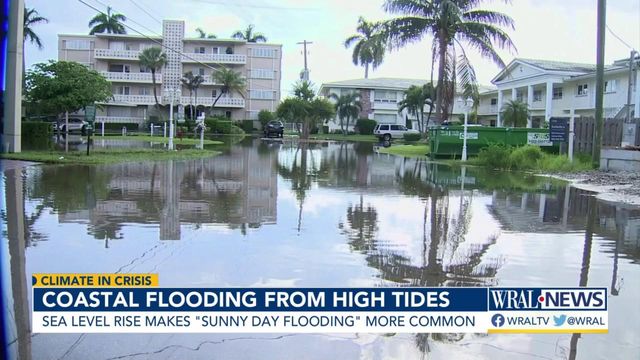Sunny day flooding: NC coastal communities threatened by rising tides
We usually associate flooding with rain and hurricanes, but more and more often, coastal communities are facing what's called "sunny day flooding."
Posted — UpdatedIf you head to the coast on any given day during the peak flooding season this fall, you might find high water levels closing businesses and streets – or even just notice pools of water by roadway drains.
This is because rising sea levels are impacting the North Carolina coast. As high tides get higher, the problems they cause – and cost to fix them – is also going up.
We usually associate flooding with rain and hurricanes, but more and more often, coastal communities are facing what’s called “sunny day flooding."
This type of flooding can cause a lot of water from high tides to end up in the streets and sewer drains, causing damage. It happens twice as often now as it did two decades ago, according to the National Oceanic and Atmospheric Administration.
UNC Wilmington professor Phil Bresnahan says high tide flooding events are becoming more common across the state, too.
In response, he’s developing low-cost sensors for communities to measure water levels and water quality, which he says is getting worse with more frequent flooding.
“I'm not sure anyone’s infrastructure is ready for the changes we’re starting to see, to be honest," he said.
In places prone to sunny day flooding, such as Beaufort, stormwater systems can be inundated with corrosive saltwater, damaging pipes.
“Even on days when the tides alone might not be enough to cause flooding, our drainage systems might be backed up by seawater," he said. "It's sort of like our bathtub drain is plugged."
Add rain or extreme weather to those conditions – and it’s the perfect storm for wastewater treatment plants and drainage systems to become overwhelmed, mixing sewage into waterways.
“It's increasingly important for communities to have the tools to see what’s going on in their own water," said Bresnahan.
He says communities also need to examine the need to update infrastructure – as the problem is expected to worsen as sea level rise accelerates.
The forecast for the southeast through May of 2023: Four to seven days of sunny day flooding.
By 2050, however, federal scientists say we could see 45 to 70 days of flooding each year from high tides alone.
Related Topics
• Credits
Copyright 2024 by Capitol Broadcasting Company. All rights reserved. This material may not be published, broadcast, rewritten or redistributed.






